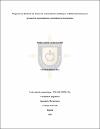Mostrar el registro resumido del documento
Propuesta de diseño de un sistema de entrenamiento asistido por realidad aumentada para personal de mantenimiento en la industria farmacéutica
| dc.contributor.advisor | Beltrán-Roa, Elizabeth |
| dc.creator | Farfán-Carrillo, Rafael Andrés |
| dc.date.accessioned | 2023-10-30T21:06:23Z |
| dc.date.available | 2023-10-30T21:06:23Z |
| dc.date.created | 2023-10-16 |
| dc.identifier.uri | http://repositorio.uniagustiniana.edu.co/handle/123456789/2474 |
| dc.description | Los avances reales en las tecnologías de las TIC están impulsados por dos tendencias que fomentan cambios de paradigma fundamentales en la interacción y el procesamiento de la información. Por un lado, las tecnologías informáticas móviles y de teléfonos inteligentes ofrecen plataformas altamente sofisticadas que integran CPU sensoriales multimodales y potentes; por otro lado, la información está estructurada georreferenciada y vincula información a ubicaciones específicas dentro de nuestro entorno. La Realidad Aumentada (AR) se ha convertido en una tecnología clave, ya que analiza los datos de los sensores (cámara, GPS, inercial) para derivar la pose detallada del sistema móvil, para correlacionar nuestro entorno real con el espacio de información georreferenciado. Por lo tanto, la AR realiza una interacción basada en cámara que fusiona la visión por computadora con los gráficos por computadora. |
| dc.description.abstract | Real advances in ICT technologies are driven by two trends that foster fundamental paradigm shifts in interaction and information processing. On one hand, mobile computing and smartphone technologies provide highly sophisticated platforms that integrate multimodal sensory and powerful CPUs; on the other hand, information is georeferenced and links data to specific locations within our environment. Augmented Reality (AR) has become a key technology as it analyzes sensor data (camera, GPS, inertial) to derive the detailed pose of the mobile system, correlating our real environment with georeferenced information space. Therefore, AR performs a camera-based interaction that merges computer vision with computer graphics. The significant advantage of utilizing AR for training is that trainees can interact with real-world objects and simultaneously access virtual information for guidance. Thus, they can easily bridge the gap between training and actual tasks. Additionally, they can perform the real task while accessing supplementary training material, facilitating learning. |
| dc.format.mimetype | application/pdf |
| dc.language.iso | spa |
| dc.rights | Attribution-NonCommercial-NoDerivatives 4.0 Internacional |
| dc.rights.uri | http://creativecommons.org/licenses/by-nc-nd/4.0/ |
| dc.source | reponame:Repositorio Institucional UniARI |
| dc.source | instname:Universitaria Agustiniana |
| dc.subject | Realidad aumentada |
| dc.subject | Unity |
| dc.subject | Mantenimiento industrial |
| dc.subject | Sistema de entrenamiento |
| dc.title | Propuesta de diseño de un sistema de entrenamiento asistido por realidad aumentada para personal de mantenimiento en la industria farmacéutica |
| dc.type | info:eu-repo/semantics/bachelorThesis |
| dc.rights.accesRights | info:eu-repo/semantics/restrictedAccess |
| dc.rights.acceso | Restringido (Temporalmente bloqueado) |
| dc.subject.keyword | Augmented reality |
| dc.subject.keyword | Unity |
| dc.subject.keyword | Industrial maintenance |
| dc.subject.keyword | Training system |
| dc.type.hasVersion | info:eu-repo/semantics/acceptedVersion |
Archivos en el documento
Este documento aparece en la(s) siguiente(s) colección(ones)
 Esta obra está bajo licencia internacional Creative Commons Reconocimiento-NoComercial 4.0.
Esta obra está bajo licencia internacional Creative Commons Reconocimiento-NoComercial 4.0.

